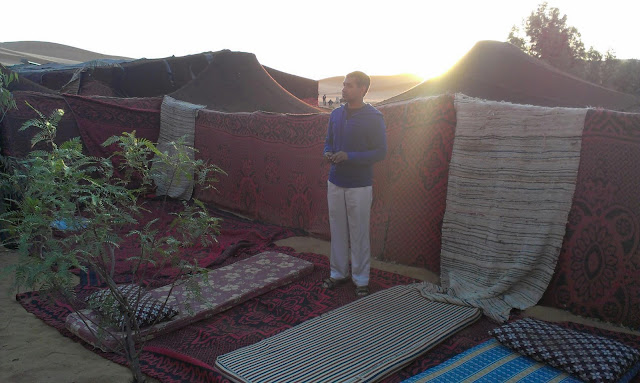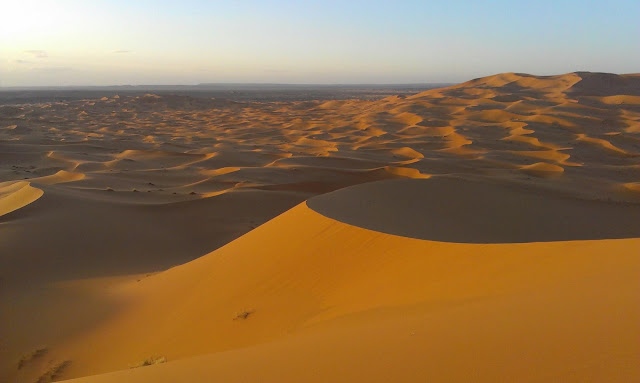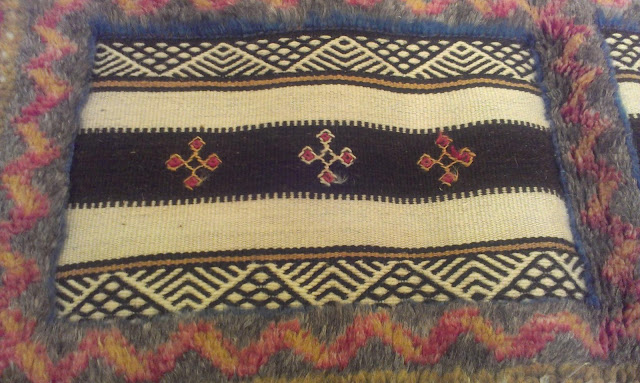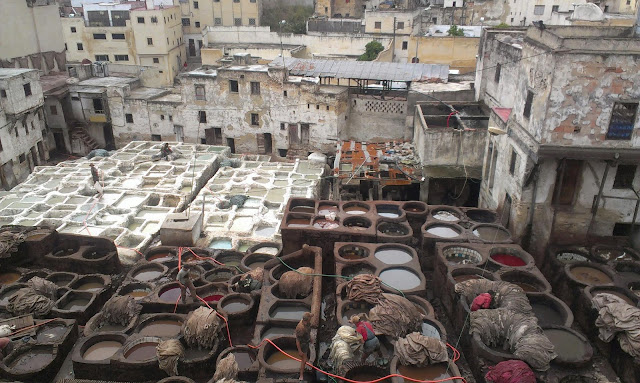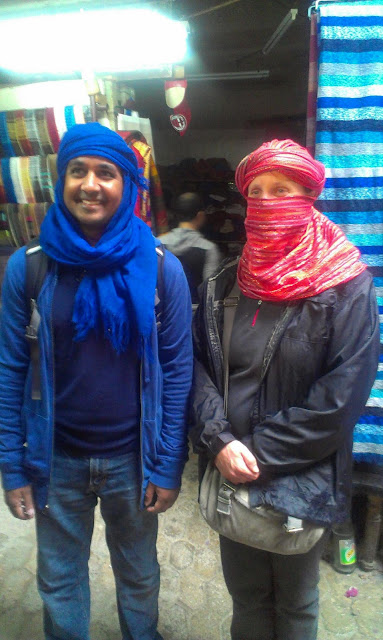Tuesday, May 28, 2013
Barcelona
The inside of the bulding is even more impressive. The ceiling soars high above as sunlight pours through the numerous skylights. Even the concrete surrounding skylights and lights is edged with rays of light. Interior columns are topped with capitals unlike any in the world. The museum describes these capitals via nature's mathematical interpretation of cones and cylinders. Sprouting from them, girders grow like branches to hold up the ceiling far above us. Gaudi's masterpiece contains familiar cathedral highlights: a beautiful stain-glassed rose window, a pipe organ, a choir. However, his artistic flair shows through in a choir that is high above the ground, the use of rolling, wave-like lines instead of straight and a wall-sized plaque with "Give Us this Day Our Daily Bread" in multiple languages. Buy the La Familia Sagrada + Museo pass; and, you'll also get entrance into the museum that was once Gaudi's house in Guell Park.
Spanish food. In just over 24 hours, I managed to eat all my favorite Spanish food. If you're lucky enough to travel to Spain, try the paella. Since Spain is a peninsula, the seafood is fresh and flavorful. Paella is made with seafood and rice. We ate paella with mussels, crawfish, and shrimp. Delicious! A simple breakfast or lunch in Spain consists of a bocadilla with jamon iberica (Spanish ham) and queso (cheese). You'll specifically want to ask for the jamon iberica. This thinly sliced, cured pork is unlike anything that I can find in the States. Finally, for the sweet tooth, Spain provides chocolate (hot chocolate) con churros (long, donuty columns). The chocolate is dark and thick. Dip your churros into the chocolate for a great sweet, any time of the day.
Hotel. Adding this in as an after thought. However, Bonanova was in a great location to the sites. However, I remember thinking that it was too expensive. My idea of "expensive" has probably changed since then. https://www.bonanovasuite.com/
Ouarzazate, Kasbah Ait Ben Haddou and Marrakech
From Ourzazate, we drove 30 km outside of the city to the kasbah made famous in Lawrence of Arabia, Kasbah Ait Ben Haddou. Originally, it was a fortress for approximately 50 middle class and six upper class families with a total of 166,000 inhabitants. However, today, only a few families still live in the kasbah. Most have moved across the flooding riverbed to the small town, which has access to a main road. We climbed the straits and steps to the very top of the kasbah, which used to be the final fortress and storehouse, if the kasbah came under siege. Beautiful view!
Finally, we drove to the exotic city of Marrakech. We thought about simply stopping for a couple of hours and then flying straight to Barcelona. However, our tour company insisted that we needed to see the central square at night in Marrakech. We stayed in the medina, or old city, in Marrakech and wandered through the souks, or shopping areas, until we came to the main square: Jemaa al-Fnaa. Due to tourism, the entire area is very well signed with areas pointing to Jemaa al-Fnaa and various areas within the souks. The Jemaa al-Fnaa was a beehive of activity. There were street performers--snake charmers, magicians, dancers. If we stopped for more than 60 seconds, roving vendors would approach us. Fresh produce (dates, almonds, tangerines) booths lined one section and restaurants lined another. The greetings of "Bonjour, Hola, Hello" filled the air as we strolled past the sensory overload. What a great way to end our tour of Morocco!
For those who would like to travel to Morocco, I highly recommend our tour company, which provided us with a private van and driver and created an itinerary for our timeframe and places we wanted to see: http://www.thetravelsource.net/
Friday, May 24, 2013
Desert
We journeyed 9 hours from Fez through the snowy Middle Atlas Mountains down to the desert to meet the four wheel drive Land Cruiser that would take us to our camels. The drive to the Kasbah with our camels took about 45 minutes over gravelly sand. At the Kasbah, we and our backpacks mounted our camels for a one hour meander over endless sand dunes.
I've heard that camels spit; but, thankfully, none of them did. Our group was 5 camels tied together. The guide led our 'caravan' with a rope tied through the nose of the first camel. Camels are amazingly well built for the desert with their soft padded feet sloshing through the sand. However, riding a camel is not as comfortable as it appears. Going up hill went well. Going downhill, I clung to the hand holds and braced myself not to catapult over the camel's neck. It was a long hour ride. On the way back the next day, I decided I would walk with our guide.
When we arrived and dismounted at our tents (camels have some tough front knees), the guides encouraged us to quickly summit the highest dune in order to see sunset. As we attempted to scurry, we discovered how exhausting it was to walk in the sand. I reneged on walking with the guide the next day. Several times, I stopped to catch my breath. Yet, we still summitted in time to see sunset. Swiftly, the air cooled as the sun disappeared. We cruised down the slope to waiting mint tea and dinner.
I haven't written much about Moroccan cuisine. The signature dish is the tajine, which is a clay pot with meat and vegetables. Usually, this is preceded by Moroccan salad, which is a variety of cooked veggies (beets, carrots, eggplant, zucchini) and beans (fava). And followed with either fruit or cookies. No meal is complete without a flat, soft bread. Our tajine in the desert was a tajine to end all tajines. Chicken, eggplant, and zucchini all in one big pot, followed by wonderfully sweet watermelon, accompanied by two guides providing some after dinner drumming.
Finally, our guides led us to our tents, which were heavy blankets on wooden frames. The doors were heavy, woven rugs. Our beds were small twin mattresses with sheets and heavy woolen blankets. Although I'd planned on sleeping outside, the large moon shone so brightly, we didn't even need flashlights. I curled up under the warm blankets inside the dark tent and fell asleep to the sounds of drumming and clapping from a nearby group.
Morning light crept through the blanket tent; and, I hurried out to see the sun crest the eastern sand dunes. We only hiked about halfway up the western dune for a vantage point this morning. Neither sunset nor sunrise provided brilliant colors. Perhaps the air is too clean to prism any sunlight. After the sun crested, we ate a light breakfast of bread and tea. Then, we mounted our camels for our return to the kasbah and our waiting Land Cruiser.
Thursday, May 23, 2013
Fez
Fez. It's a word that brings back childhood memories of our small town parade. Shriners in little red hats drove tiny vans in circles and figure eights through the street. However, the city of Fez has a much richer tradition. It was founded around 800 A.D. and has served off and on as a capital city. For a word so synonymous with a red felt hat, we saw only one vendor selling a total of four fezes during our entire day walking the Medina.
The Medina is the original, 'old' part of Fez, from the 800s. Its not to be confused with 'new' Fez, which was built in the 1400s. I highly recommend hiring a guide for a tour of the Medina. It's labyrinth of 9600 streets is an enigma for even the most seasoned traveler. We started our walking tour just outside the Medina in the Mellah, or old Jewish Quarter. From there, we wove in and out among shops, homes, and restaurants in streets sometimes not more than shoulder width. The entire area is free of motorized vehicles. Goods are transported via hand cart or small horse. Often, we squeezed against the walls to get out of the way of both. Whether shopping for dates, artichokes, almonds or fava beans, there is an abundance of fresh food, including shark and sheep brains. There are tanners, copper smiths, spice vendors, rug makers, and weavers. The Medina also boasts one of the oldest universities in the world.
Tannery: the sprig of mint that you're given upon entrance does little to mask the smell. We moved past exquisite leather work to the back windows. Outside, hides are soaking in limestone vats or being dyed manually by men standing in large vats full of colored water.
Coppersmith: need to cook in bulk for your next big party? Here, you can rent a large copper pot to do your cooking.
Spice vendors: Moroccan has that most expensive and exotic of spices, saffron. It also boasts the argot nut. The oil of this nut is used in expensive cosmetics internationally.
Weavers: scarves and djellabis (long robes with hoods) are worn everywhere. Handmade ones are still woven on wooden looms from cotton, wool and vegetable silk (agave fibers).
Rugs: you'll shop three types of rugs here: Arabic, Berber and nomadic. Each is distinctly different. Arabic rugs look most like flying carpets. Berber rugs have distinct symbols or tattoos. Nomadic rugs are made from either 'live' or 'dead' wool, depending on if the animals are shorn when they're alive or dead. No dyes are used in nomadic rugs.
Kaireoune Mosque and University: founded by a woman, Fatima, in the 800s, this continues as a university to this day.
Tuesday, May 21, 2013
Gibraltar
flying into Gibraltar is not for the faint of heart. The plane cruises past the Rock, descends over the Straight toward the Atlas Mountains in Morocco, and turns back for a short taxi on a runway built on the water. While the runway stretches ahead, from the windows you see the traffic waiting to cross the one road into Gibraltar. Cars, cyclists and pedestrians all pass from Spain into Gibraltar on the road crossing the runway. The planes land, turn 360 degrees and taxi back to the terminal. Traffic is stopped for four flights per day.
Gibraltar is definitely a day trip. This rock has been owned and coveted by many nations. Currently, its owned by the UK. It's very unique to experience a little bit of Britain, attached to the Spanish mainland. We heard just as much Spanish as English spoken.
The attractions on the Rock include some old fortresses, a cave and Barbary monkeys. Options to summit the rock include stairs as well as a gondola. The Nature Reserve pass will get you entrance to all attractions (we paid 18.50 pounds for gondola up plus nature reserve). There are signs posted everywhere not to touch or feed the monkeys and to keep everything secure. Yet, even verbal warnings did not prevent one couple from losing their snack (It's a 500 Euro fine to feed the monkeys) nor a family from letting their toddler son run up to pet a monkey (& subsequently get slapped by the monkey).
The fortresses include old batteries, several tunnels built for the Great Siege in the 1700s and expanded through WWII, and a Moorish fortress originally constructed in 1333. St. Michael's Cave is tastefully lit to highlight the rock formations. From there, its a short walk uphill to the start of the Mediterranean Steps down and around the west side of the Rock.
On our descent by stairs back to the main plaza, we met a resident of Gibraltar. He walks the stairs 5-6 times per day. My quads and calves are on fire after only one day of stairs.








